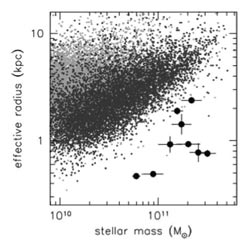The Milky Way Galaxy is relatively typical of galaxies today, if a bit on the beefy side. It has about 200 billion stars, and is 100,000 light years across.
Now imagine a galaxy with that same mass, but only 5000 light years across. That would be an incredibly densely packed galaxy, and in all honesty, pretty freaky.
But that’s exactly what astronomers using Hubble and Keck have found! Probing the early Universe, 11 billion light years away, they found nine galaxies that are as massive as galaxies today, but far more compact. The galaxies are very young, only a half to one billion years old, judging from the types of stars they contain. Not only that, they appear to be quiet: unlike our galaxy today, these distant compact galaxies are not actively forming stars. It’s as if they formed all their stars all at once right from the start, and then that was that.
 |
| This plot shows that these galaxies really are small and massive. Size is shown on the vertical scale (bigger galaxies are near the top) and mass along the horizontal (more massive galaxies to the right). A big massive galaxy would be to the upper right, and a low mass, dinky galaxy to the lower left. These oddballs are marked, and are clearly separate from other galaxies: they are massive, yet small. |
That’s really weird! What could cause such galaxies to form so tightly jammed with stars? One idea is that in the early Universe there were pockets of dark matter, places where it was somewhat denser than on average. Hydrogen would have collected there, attracted by the fierce gravity, and formed the galaxies. Constrained by the dark matter pockets, the galaxies would have been very dense and formed stars furiously for a short period until all the hydrogen was used up. That would explain their small stature, dense stellar population, and lack of ongoing star formation. But it’s just a hypothesis for now.
What’s also odd is that we do not see any galaxies like these today; any galaxy of comparable mass that we see in the current Universe today is far larger, like our Milky Way. So these galaxies existed in the past – possibly in large numbers – but we don’t see them now. Where did they go?
They may get bigger with time. It’s not clear how they would do that, but perhaps the more massive stars fall to the center, flinging lighter stars outward, puffing up the galaxies over time (I describe this process a bit in a post yesterday about globular clusters). Maybe they collide and puff up – though that means they would get even more massive than we see them, and they’re already as hefty as galaxies today. Maybe they grow dark over time, and we just don’t see them any more.
Actually, I don’t like any of these answers very much. We obviously need a lot more observations of these tiny dense suckers. However, we’re pretty much at the limit now; it took Hubble’s and Keck’s incredible resolution to be able to see these things at all. We’ll have to wait for the Hubble servicing mission in September to get even deeper images, when the new Wide Field Camera goes online. I suspect that STIS, the spectrograph that I used to work on, may be able to help as well, if the astronauts can fix it too.
Either way, it’s cool to know the Universe can still throw us the odd curveball or two. The more we look, the more weirdness we find.